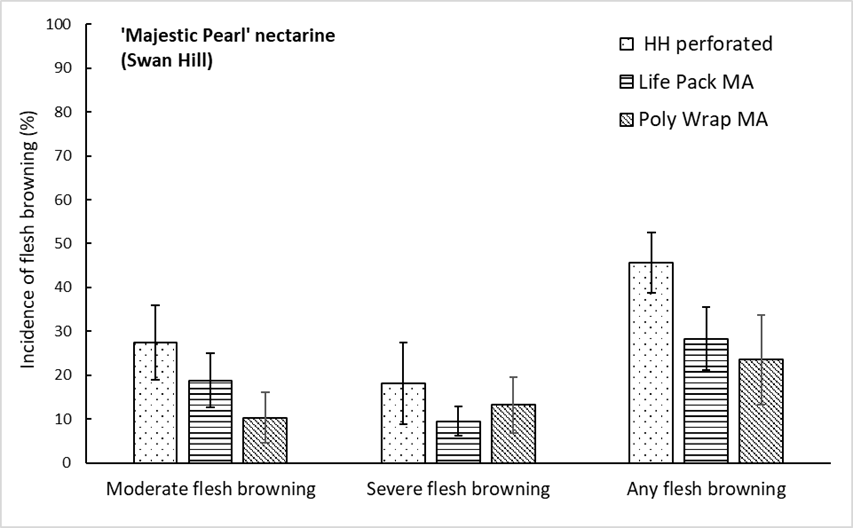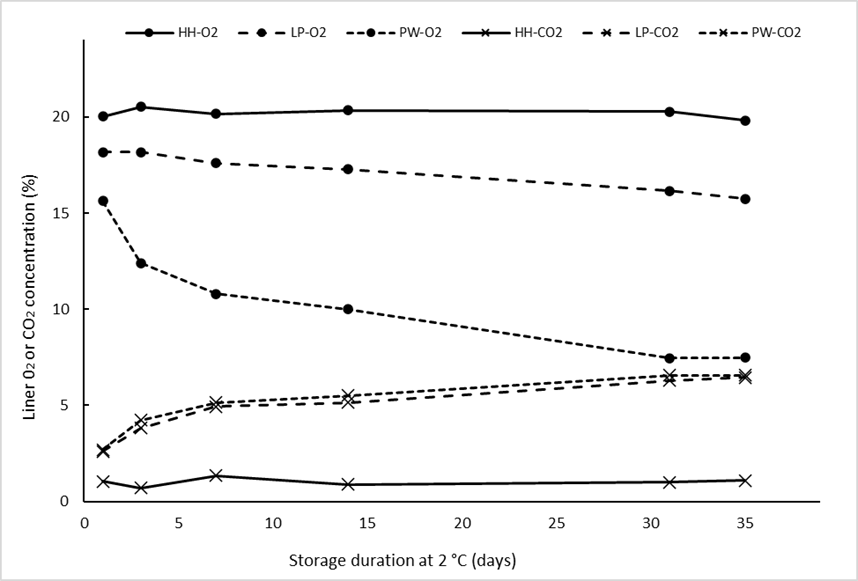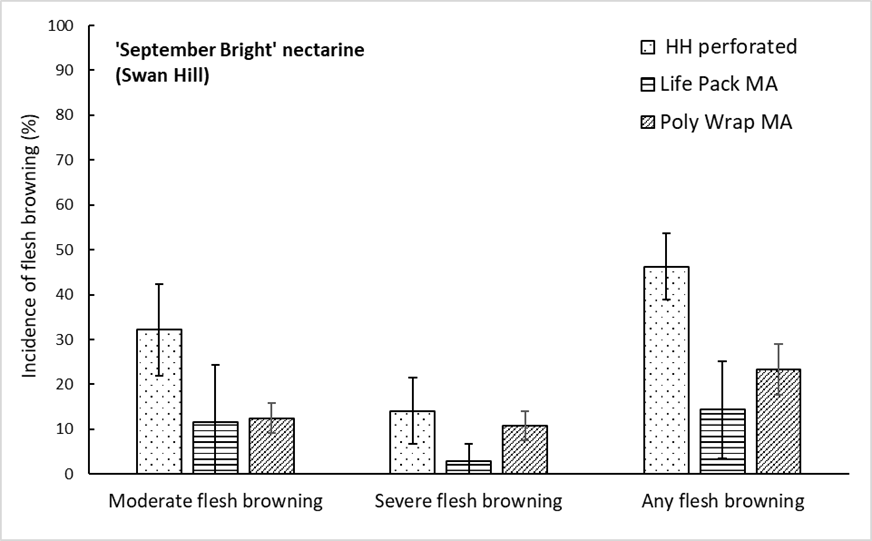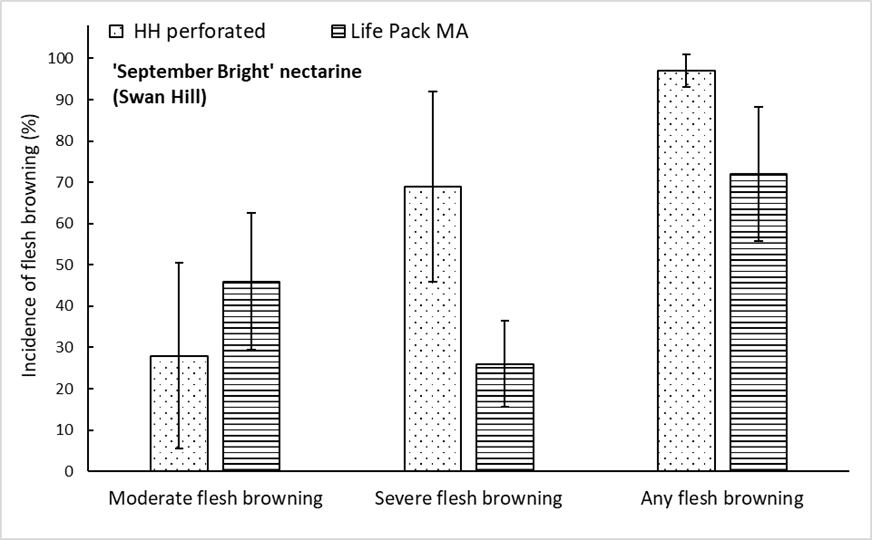Does modified atmosphere packaging (MAP) extend the storage potential of nectarines during sea freight export?
Objective:
Determine the effectiveness of commercially available modified atmosphere packaging (MAP) to extend nectarine storage potential and reduce storage disorders during simulated sea freight.
On this page:
Commercial implications of findings
Summary of experimental findings
Effective use of modified atmosphere packaging (MAP) for sea freight export of stone fruit (Note: this document does not meet WCAG 2.0 accessibility guidelines)
Commercial implications of findings
Modified atmosphere packaging (MAP) are commonly used by growers and exporters for sea freight consignments to mainly reduce fruit weight loss but little information is available for specific stone fruit cultivars regarding their benefits in extending stone fruit storage potential during export. Sea freight simulations to compare commercial MAP using ‘Majestic Pearl’ and ‘September Bright’ nectarine demonstrated that MAP can effectively reduce the risk of storage disorders in fruit, as measured by flesh browning (FB) severity, and potentially extend their cool storage potential by up to two weeks, compared to perforated high humidity (HH) liners, whilst ensuring that fruit retain acceptable eating quality characteristics for the consumer after marketing.
Key research findings:
- Among low to moderately susceptible ‘Majestic Pearl’ nectarine, commercial Life Pack™ and Poly Wrap™ MAP reduced incidence of any flesh browning (FB) by approximately 50 % in relative terms compared to fruit stored in perforated high humidity (HH) liners during simulated sea freight and a marketing period, whilst both MAP reduced moderate and severe FB by 50 and 40 %, respectively, compared to fruit in HH liners.
- Among moderately to highly susceptible ‘September Bright’ nectarine, two sea freight simulations demonstrated that commercial MA liners reduced incidence of moderate or severe FB by approximately 60 % in relative terms compared to fruit stored HH liners after 35 days of cool storage and marketing, whilst Life Pack™ liners significantly reduced severe FB by 60 % compared to HH liners in ‘September Bright’ necatrine after cool storage for 42 days, a storage duration that greatly increases the risk of storage disorders in this cultivar.
- The relationship between the degree of atmosphere modification within MAP and their effectiveness in reducing storage disorders after cool storage or sea freight export has not been properly established and requires further research.
 Nectarines in Modified Atmosphere Packaging
Nectarines in Modified Atmosphere Packaging
Summary of experimental findings:
Three packaging and storage experiments were conducted on commercially harvested ‘Majestic Pearl and ‘September Bright’ nectarines grown in Swan Hill, Victoria in the 2021-22 season. Export grade fruit were supplied by two growers after grading and cool storage for approximately five to seven days at 2 °C. The experiments assessed the effectiveness of commercial Life Pack™ and Poly Wrap™ modified atmosphere packaging (MAP) in reducing quality loss and storage disorders such as flesh browning (FB) in fruit after simulated sea freight export, and a marketing period. Commercial MAP was compared to a control consisting of fruit packed in high humidity (HH) 2 mm macro-perforated high-density polyethylene (HDPE) liners.
FB severity score was utilised as a measure of the degree of chilling injury among fruit that has been associated with incomplete fruit ripening and poor eating quality due to flesh mealiness and negative changes in texture. FB severity was scored by assigning a severity rating to each fruit where 0 = none, 1 or 2 = moderate, and 3 or 4 = severe, with the incidence of any, moderate and severe flesh browning calculated from 20 fruit within a replicate carton. Fruit with severe FB symptoms would be commercially unmarketable and not suitable for eating by a consumer, whilst marketability and eating quality is unlikely to be compromised among fruit with moderate FB severity.
Among ‘Majestic Pearl’ nectarine which was stored for 42 days at 2 °C to simulate grower storage and sea freight export and ripened at 18 °C for 4 days to simulate a marketing period, both commercial MAPs significantly reduced the incidence of any FB by 17 to 23 % in absolute terms compared to perforated HH liners (Fig. 1). Although both MAPs were effective in reducing moderate FB after marketing, Poly Wrap™ liners were marginally more effective in reducing moderate FB by 18 % compared to HH MAPs. Both MA liners similarly reduced severe FB compared to the control packaging with Life Pack™ liners reducing severe FB to under 10 % compared to 18 % FB incidence observed in HH liners.
Oxygen (O2) and carbon dioxide (CO2) concentrations within the three commercial liners varied considerably with little change in atmospheric conditions observed within HH liners during cool storage. Increases in CO2 concentration up to 6 % among both MAPs, but a much greater reduction in O2 concentration observed in Poly Wrap™ liners (Fig. 2). The impact of lower O2 concentration during cool storage on nectarine storage disorders has not been properly established.
Two similar experiments were conducted to determine the effect of MAP on the quality of ‘September Bright’ nectarine after simulated sea freight, with both commercial MAPs tested in the first trial, and the Life Pack™ MAP compared to the perforated HH liner in the second experiment.
In the first experiment, both commercial MAP significantly reduced the incidence of any FB by 20 to 30 %, and incidence of moderate FB by 20 %, in absolute terms, compared to perforated HH liners among fruit stored for 35 days at 2 °C and ripened at 18 °C for 4 days (Fig. 3). In this trial Life Pack™ MAP significantly reduced severe FB down to 3 % after marketing as compared to Poly Wrap™ MAP and HH liners, with severe FB in fruit of 11 and 14 %, respectively.
In the second experiment, incidence of fruit with moderate FB severity was higher within Life Pack™ MAP by 18 % after cool storage for 42 days and a marketing period, but large and overlapping 95 % confidence intervals for both packaging treatments suggests that this difference was not statistically significant. But Life Pack™ MAP significantly reduced incidence of fruit with severe FB by 43 % compared to the perforated HH liner treatment after a cool storage duration resulting in a higher risk of storage disorders in this cultivar.
Among all three packaging experiments little difference in flesh firmness and fruit physiological maturity was observed between packaging treatments, although fruit in perforated HH liners generally ripened and softened slightly more rapidly during simulated marketing than fruit within commercial MAP (data not shown).
Experimental methods:
Cultivar | Single experiment: ‘Majestic Pearl’ nectarine (white-flesh) Double experiments: ‘September Bright’ nectarine (yellow-flesh) |
Harvest maturity | Commercial |
Growing region | Swan Hill, Victoria |
Fruit sampling point | After grading for export (6 to 7 days after harvest) |
Packaging tested | Life Pack™ MAP, Poly Wrap™ MAP and high humidity perforated liner |
Cool storage duration and temperature | 35 or 42 days at 2 °C and >75 % RH (including harvest to packing period of 7 days) |
Marketing after cool storage | 4 days at 18 °C and >60 % RH |
Experiment replication: | Four or five 8 kg cartons per packaging type; 20 fruit per carton at each assessment |
Quality assessments | Fruit weight, fruit physiological maturity, flesh firmness, Soluble Solids Concentration (SSC), flesh browning incidence and severity score, package atmospheres (O2 and CO2 concentrations) during cool storage |
Key results:

Figure 1. Effect of packaging on incidence of moderate, severe and any flesh browning among ‘Majestic Pearl’ nectarine after cool storage for 42 days at 2 °C and ripening for 4 days at 18 °C where HH = high humidity, and MA = modified atmosphere; error bars show ± 95% confidence interval of each mean.

Figure 2. Effect of packaging on CO2 and O2 concentration among ‘Majestic Pearl’ nectarine during cool storage for 35 days at 2 °C where HH = high humidity liner, LP = Life Pack™ liner, and PW = Poly Wrap™ liner.

Figure 3. Effect of packaging on incidence of moderate, severe and any flesh browning among ‘September Bright’ nectarine after cool storage for 35 days at 2 °C and ripening for 4 days at 18 °C where HH = high humidity, and MA = modified atmosphere; error bars show ± 95% confidence interval of each mean.

Figure 4. Effect of packaging on incidence of moderate, severe and any flesh browning among ‘September Bright’ nectarine after cool storage for 42 days at 2 °C and ripening for 4 days at 18 °C where HH = high humidity, and MA = modified atmosphere; error bars show ± 95% confidence interval of each mean.
Acknowledgement
The Serviced Supply Chains II project (AM21000) is funded by the Hort Frontiers International Markets Fund, Avocado and Strawberry research and development levy, and contributions from the Australian Government, with co-investment from the Department of Agriculture and Fisheries, Queensland (DAF), the Department of Energy, Environment and Climate Action, Victoria (DEECA), the Department of Industry, Tourism and Trade, Northern Territory (DITT), the Department of Primary Industries and Regional Development, Western Australia (DPIRD), Pinata Farms Pty Ltd and Summerfruit Australia Ltd. Hort Innovation is the grower-owned, not-for-profit research and development corporation for Australian horticulture.
This publication may be of assistance to you, but the State of Victoria and its employees do not guarantee that the publication is without flaw of any kind or is wholly appropriate for your particular purposes and therefore disclaims all liability for any error, loss or other consequence which may arise from you relying on any information in this publication. While every effort has been made to ensure the currency, accuracy or completeness of the content we endeavour to keep the content relevant and up to date and reserve the right to make changes as require. The Victorian Government, authors and presenters do not accept any liability to any person the information (or the use of the information) which is provided or referred to in the report.